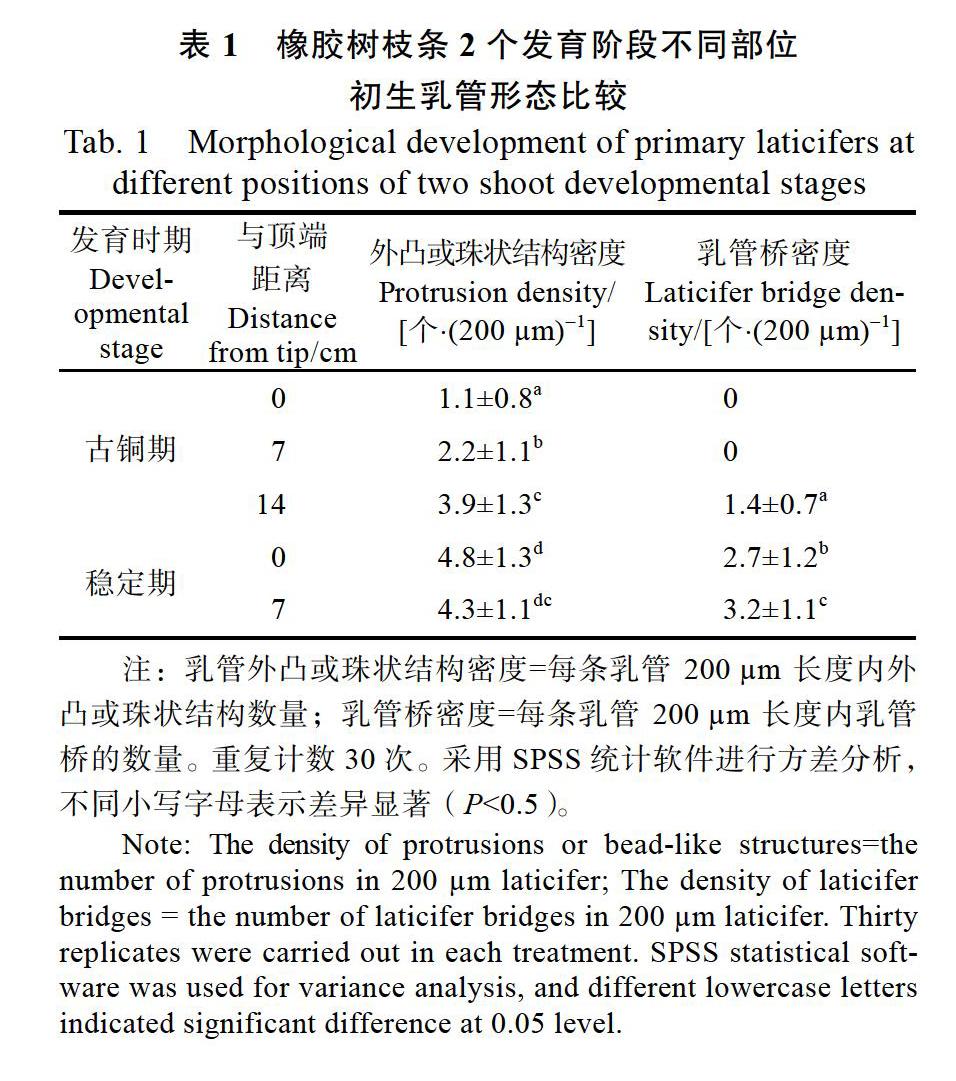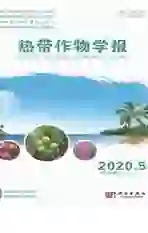橡胶树枝条初生乳管形态发育研究
2020-06-19谭德冠AnuwatKUMPEANGKEAW韩冰莹付莉莉孙雪飘张家明
谭德冠 Anuwat KUMPEANGKEAW 韩冰莹 付莉莉 孙雪飘 张家明



摘 要:橡膠树的初生乳管主要存在幼嫩树干、枝条、叶片、花和果实中,其发育过程依然不清楚。本研究利用石蜡制片和改良的碱处理剥离2种方法研究了幼嫩枝条初生乳管的形态发育过程,发现碱处理剥离法能观察到乳管从起源到发育成熟的连续过程,优于石蜡制片。采用碱处理剥离法系统研究橡胶树枝条不同发育时期初生乳管形态特征。从古铜期枝条不同部位分离的乳管形态差异较大,顶端分生组织附近的乳管呈线性长管状、不分支、无隔,外凸结构不明显;距顶端7 cm左右的乳管具有明显的外凸结构或珠状结构;距顶端14 cm处的乳管明显增粗,相邻乳管间外凸结构联结贯通形成乳管桥,最终形成网状结构。稳定期枝条各部位的乳管形态趋同,外凸或珠状结构的密度和乳管桥的密度均显著高于古铜期枝条对应的部位,都形成了复杂的网络结构。同时发现初生乳管是多核的。本研究结果表明橡胶树枝条初生乳管为无节联结乳管,是一种新的乳管类型。本研究对植物乳管发育研究有重要意义。
关键词:橡胶树;初生乳管;乳管新类型;无节联结乳管
中图分类号:S794.1 文献标识码:A
Morphological Development of Primary Laticifers in Shoots of Hevea brasiliensis Muell. Arg
TAN Deguan1, Anuwat KUMPEANGKEAW1,2, HAN Bingying1, FU Lili1, SUN Xuepiao1, ZHANG Jiaming1*
1. Institute of Tropical Bioscience and Biotechnology, Chinese Academy of Tropical Agricultural Sciences (CATAS) / Hainan Academy of Tropical Agricultural Resource, CATAS / Key Laboratory of Tropical Crop Biology and Genetic Resources, Ministry of Agriculture and Rural Affairs, Haikou, Hainan 571101, China; 2. Song Khla Rubber Research Centre, Department of Agriculture, Ministry of Agriculture and Cooperatives, Had Yai, Song Khla 90110, Thailand
Abstract: The primary laticifers of Hevea brasiliensis Muell. Arg present mainly in young trunks, shoots, leaves, flowers, and fruits. However, its morphological development is unknown. Two methods, parafin section and modified alkali-treated stripping were used to study the development of the primary laticifers in this study, and the latter was found superior to the former by continuous observation of the whole developmental process. The morphological development of the primary laticifers of different stages was systematically investigated using the modified alkali-treated stripping method. The results showed that the laticifers isolated from different positions of the bronze-stage shoots were morphologically distinct. The laticifers close to the apical meristem were longtube-like linear structures without end-walls and branches, and protrusive growth was not obvious. The lacifers at 7 cm away from the apical meristem had obvious intrusive growth and bead-like structures, which resulting in increase in the diameter of laticifers. The laticifers at 14 cm away from the apical meristem were significantly enlarged in diameter, and contained more bead-like structures, and the bead-like structures between the neighboring laticifers were connected to form laticifer bridges, which resulting in the formation of a laticifer network. The laticifers isolated from different positions of the stable-stage shoots were morphologically similar, and the density of the protrusions or bead-like structures and the laticifer bridges was significantly higher than that in bronze-stage shoots, and complex laticifer networks were formed in the barks at all positions. The primary laticifers were proved to be multinuclear as well. The results of this study indicate that the primary laticifers in the rubber tree shoots are non-articulated and anastomosing, and belong to a novel type of laticifers. This study would play an important role in the fundamental research of the plant laticifer development.
Keywords: Hevea brasiliensis Muell. Arg; primary laticifer; novel type of laticifer; non-articulated and anastomosing laticifer
DOI: 10.3969/j.issn.1000-2561.2020.05.006
橡胶树(Hevea brasiliensis)属大戟科橡胶属,是热带地区重要的经济作物。据不完全统计,全球产胶作物12500多种,由于橡胶树所产天然橡胶具有产量高、易采收、质量好等优势[1],是商品天然橡胶的主要来源。
乳管是指一种含有胶乳的特化细胞或一列含有胶乳的并合细胞[2],它也是橡胶树胶乳生物合成、贮存和运输的场所[3]。橡胶树的乳管分为2种类型,初生乳管和次生乳管[4-5]。初生乳管是植物体初生生长时形成的乳管,主要存在橡胶树的幼嫩树干、枝条、叶片、花和果实中,而次生乳管主要存在树干中[6-7]。橡胶树中初生乳管的胶乳含有一些有毒物质,如羟基腈水解酶,可用来催化腈基类化合物水解,释放氢氰酸,抵御害虫和病原菌的侵害[8]。
目前尚欠缺对橡胶树初生乳管系统发育的研究。吴继林等[4]采用石蜡制片的组织化学染色法研究橡胶树幼茎中初生乳管的发育,认为其为有节联结乳管;而采用剥离的方法观察到幼茎中初生乳管具有很多长的分枝,认为橡胶树初生乳管为无节乳管[9]。导致这些研究结果的差异可能是由于研究方法和研究材料的差异所造成。本研究采用了改良的碱处理剥离法,系统研究橡胶树枝条不同发育时期、不同部位初生乳管的形态特征,克服了前人研究的局限性,发现橡胶树初生乳管属于一种新型乳管类型——无节联结乳管。
1 材料与方法
1.1 材料
橡胶树品种‘热研7-33-97芽接苗种植于中国热带农业科学院热带生物技术研究所苗圃中,分别选取古铜期和稳定期的枝条作为实验材料。
1.2 方法
1.2.1 石蜡制片的组织化学染色法研究枝条初生乳管 石蜡制片的组织化学染色法参考田维敏等[10]的方法进行。用古铜期的枝条作为实验材料,选取距离顶端分生组织14 cm处的茎段,立刻置于75%乙醇中,抽真空,室温固定2 d。将固定好的材料经乙醇系列脱水,冰醋酸过渡处理4 h,溴碘染液处理48 h,冰醋酸浸洗3次(每次2 h),无水乙醇置换冰醋酸3次(每次1 h),经正丁醇透明后进行石蜡包埋、切片,切片厚度10 ?m。切片用二甲苯脱蜡,固绿染色,二甲苯透明,中性树胶封片,光学显微镜下观察研究初生乳管。
1.2.2 改良的碱处理剥离法分离和研究初生乳管 橡胶树枝条初生乳管的分离参考Zhao[9]的碱处理剥离法,并进行改良。选取古铜期和稳定期的枝条,去除叶片,分别切取顶端分生组织部位和距顶端7、14 cm处的茎段,立刻置于75%乙醇中,抽气后室温条件下固定2 d。将固定好的茎段置于10% KOH溶液中,100 ℃处理10 min,再置于自来水中漂洗30 min,于解剖镜下用镊子小心将乳管从树皮中分离出来。
用溴碘染色法[10]对剥离的初生乳管染色。剥离的初生乳管经乙醇/正丁醇系列脱水,醋酸过渡处理2次,每次30 min,溴碘染液染色10 min,光学显微镜下观察乳管的形态。
1.2.3 初生乳管细胞核观察 将初生乳管从古铜期枝条剥离出来,乙醇/正丁醇系列脱水,石蜡包埋,滑走切片机上切片,切片厚度为8 ?m。切片用二甲苯脱蜡,于环已烷溶液中处理6 h。将处理好的切片复水,于卡宝品红染液中处理8 min,光学显微镜下观察乳管细胞核情况。
2 结果与分析
2.1 2种制片方法观察乳管形态的比较
石蜡制片是研究植物乳管的經典方法,已被广泛应用于研究橡胶树乳管发育[11-13]。碱处理剥离法应用较少。本研究以距顶端分生组织14 cm的古铜期枝条嫩茎为材料,比较了2种制片方法的观察效果。
利用石蜡制片法,观察到初生乳管细胞、乳管细胞之间的桥联结构以及乳管外凸结构(图1A,图1B)。然而,由于乳管是弯曲的延伸结构,不在同一平面,乳管在同一个切片上往往时隐时现(图1A,图1B),一次只能观察到乳管的局部。需要通过观察多个切片,来推测乳管网络的结构。另外,由于有时脱蜡不充分,或者受乳管周围细胞的细胞壁折射的影响,可能观察到疑似端壁的结构(图1C),因而将初生乳管误判为有节乳管。
利用改良剥离法分离到完整的乳管网络,可以将整个乳管网络放在同一个平面上观察(图1D,图1E)。可以观察到石蜡切片中所观察到的外凸结构、乳管之间的桥联结构、乳管的3D结构等,还可以排除石蜡和周围细胞对观察结果的影响。
另外,石蜡制片操作步骤烦琐,实验周期较长;改良碱处理剥离法操作简单方便,实验周期短。综上所述,改良碱处理剥离法优于石蜡制片法。
A、B、C:石蜡制片染色法研究距顶端分生组织14 cm处初生乳管(纵切面);D与E:改良碱处理剥离法研究相同部位初生乳管,其中E为初生乳管3D图象。蓝色箭头所示初生乳管;红色箭头所示乳管桥;绿色箭头所示外凸或珠状结构;
紫色箭头所示疑似端壁结构。标尺=40 ?m。
2.2 用改良的碱处理剥离法研究橡胶树枝条初生乳管形态发育
橡胶树枝条发育经历古铜期、变色期、淡绿期、稳定期等4个阶段[14-15]。新抽出的枝条呈现古铜色(图2A);随着发育,叶片颜色逐渐变绿。当发育到稳定期时,茎段硬化,叶片变为深绿色。为了系统研究橡胶树枝条初生乳管发育过程中的形态变化,本研究以古铜期和稳定期的枝条为研究材料,采用改良的碱处理剥离法对2个发育时期枝条中不同部位的乳管进行观察研究。
本研究只对橡胶树枝条初生乳管的发育进行研究,橡胶树的叶片、花、果实、根等器官也存在初生乳管,这些器官初生乳管类型及其发育模式是否与枝条相似依然未知,尚需对它们初生乳管的发育进行系统研究。
参考文献
Hagel J M, Yeung E C, Facchini P J. Got milk? The secret life of laticifers[J]. Trends in Plant Science, 2008, 13(12): 631-639.
谭德冠, 孙雪飘, 张家明. 植物乳管研究进展[J]. 植物生理学报, 2011, 47(11): 1033-1038.
Gomez J B. Anatomy of Hevea and its influence on latex production[M]//Annual Report. Kuala Lumpur: Malaysia Rubber Research and Development Board Monograph (Malaysia), 1982: 1-2.
吴继林, 谭海燕, 曾日中, 等. 巴西橡胶树初生乳管分化与苗生长的关系[J]. 热带作物学报, 2000, 21(4): 1-6, 85-88.
Wang X, Shi M, Wang D, et al. Comparative proteomics of primary and secondary lutoids reveals that chitinase and glucanase play a crucial combined role in rubber particle aggregation in Hevea brasiliensis[J]. Journal of Proteome Research, 2013, 12(11): 5146-5159.
Sando T, Hayashi T, Takeda T, et al. Histochemical study of detailed laticifer structure and rubber biosynthesis-related protein localization in Hevea brasiliensis using spectral confocal laser scanning microscopy[J]. Planta, 2009, 230(1):
215-225.
Mahlberg P G. Laticifers: an historical perspective[J]. The Botanical Review, 1993, 59(1): 1-23.
丁 梅, 吴坤鑫, 谭德冠, 等. 橡胶树羟基腈水解酶基因的克隆、表达和基因家族分析[J]. 热带作物学报, 2016, 37(11): 2170-2175.
Zhao X Q. The significance of the structure of laticifer with relation to the exudation of latex in Hevea brasiliensis[J]. Journal of Natural Rubber Research, 1987, 2(2): 94-98.
田维敏, 史敏晶, 谭海燕, 等. 橡胶树树皮结构与发育[M]. 北京: 科学出版社, 2015: 245-246.
Hao B Z, Wu J L. Laticifer differentiation in Hevea brasiliensis: induction by exogenous jasmonic acid and linolenic acid[J]. Annals of Botany, 2000, 85(1): 37-43.
Tian W M, Yang S G, Shi M J, et al. Mechanical wounding-induced laticifer differentiation in rubber tree: an indicative role of dehydration, hydrogen peroxide, and jasmonates[J]. Journal of Plant Physiology, 2015, 182: 95-103.
Cao Y, Zhai J, Wang Q, et al. Function of Hevea brasiliensis NAC1 in dehydration-induced laticifer differentiation and latex biosynthesis[J]. Planta, 2017, 245(1): 31-44.
戴雪梅, 楊先锋, 辛士超, 等. 橡胶树叶片原生质体分离条件的优化[J]. 热带农业科学, 2018, 38(3): 46-52.
王立丰, 陆艳茜, 邓玉杰. 光照强度对巴西橡胶树淡绿期叶片光合特性和活性氧代谢的影响[J]. 热带作物学报, 2014, 35(6): 1131-1136.
史自强, 胡正海. 植物含橡胶组织的制片方法[J]. 植物学报, 1965, 13(2): 179-183.
Tan D, Sun X, Zhang J. Histochemical and immunohistochemical identification of laticifer cells in callus cultures derived from anthers of Hevea brasiliensis[J]. Plant Cell Reports, 2011, 30(6): 1117-1124.
Salvucci M E, Coffelt T A, Cornish K. Improved methods for extraction and quantification of resin and rubber from guayule[J]. Industrial Crops and Products, 2009, 30(1): 9-16.
Chen Y, Gao X, Zhang X, et al. Relationship between the number of tapping-induced secondary laticifer lines and rubber yield among Hevea germplasm[J]. Frontiers of Agricultural Science and Engineering, 2016, 3(4): 363-367.
Pickard W F. Laticifers and secretory ducts: two other tube systems in plants[J]. New Phytologist, 2008, 177(4): 877- 888.
